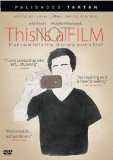| Reviews & Columns |
|
Reviews DVD TV on DVD Blu-ray 4K UHD International DVDs In Theaters Reviews by Studio Video Games Features Collector Series DVDs Easter Egg Database Interviews DVD Talk Radio Feature Articles Columns Anime Talk DVD Savant Horror DVDs The M.O.D. Squad Art House HD Talk Silent DVD
|
DVD Talk Forum |
|
|
| Resources |
|
DVD Price Search Customer Service #'s RCE Info Links |
|
Columns
|
|
|
This Is Not a Film
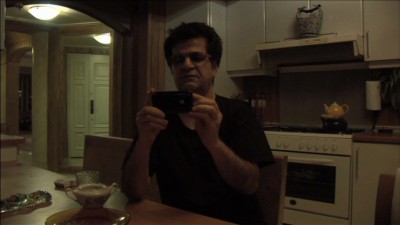
Please Note: The screen grabs used here are taken from the DVD-R check disc provided for review, not the official DVD edition of the film.
Jafar Panahi, the Iranian filmmaker whose best-known film outside of his homeland is probably 1995's The White Balloon, is by most definitions a successful artist, and he wears his success with an assured but humble degree of comfort and confidence. In his 2011 movie This Is Not a Film, a quasi-documentary in which Panahi is present in every shot, his demeanor and temperament are even-keeled and relaxed; he seems perfectly at ease as he discusses the ins and outs of every aspect of his work and craft from writing, pitching, and revising scripts to casting, location scouting, and rolling with the serendipitous accidents of shooting. But what makes Panahi's normal-seeming calm collectedness in his role as well-established auteur surprising at first, then very moving as the film progresses, is that he maintains it so well despite his unasked-for role as an embattled artist, a filmmaker who's found himself on the wrong side of a state censorship apparatus that has the power to shut off his living and his lifeblood by banning him from making films or leaving the country, and even by sentencing him to prison. This is, in fact, a power that the Iranian censors and prosecutors have used, to international public protest, in retaliation for Panahi's recalcitrance, his insistence on continuing to make and release (outside of Iran) his officially-unapproved films (like 2003's Crimson Gold and 2006's Offside). Panahi's charming, chatty appearance as a slightly rumpled, middle-aged urban intellectual/creative type belies his role as a rebel and artistic freedom-fighter, even as this deceptively self-deprecating film, subtly packed with urgency as it is, manages to evade any sense of the rage or desperation to which someone in Panahi's position would have every right.
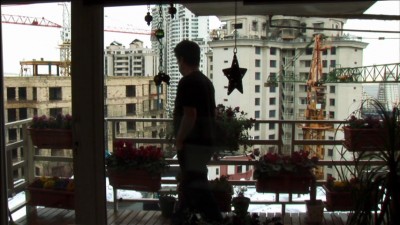
That clear-headed, pragmatic, down-to-earth quality, both in Panahi's persona and in the form of the film itself (it was shot on digital video, with some gorgeous framings but a raw, available-light quality to the images, mostly made by its nominal "director," Panahi's colleague Mojtaba Mirtahmasb, who at the time of shooting was not himself banned from filmmaking) keeps the film from ever being a soapbox or merely topical (as understandable, again, as that would be). At first, the film takes on the guise of a day in the life of Jafar Panahi, hanging out with him in his comfortably upper-middle-class flat amid the Tehran skyline. Much of Panahi's routine seems to consist of embroilment in ongoing legal proceedings, pursuing most likely futile attempts to lighten his sentence or reduce the 20 years' ban on any filmmaking activity he's been slapped with, and illustrative moments from his never-ending slog through the red tape of his persecution were bound to make their way in, so we're never unaware of what he's dealing with daily or the grim creative and personal future he faces. The magnitude of what we're experiencing in This Is Not a Film, then, isn't immediately clear; during the first 15 minutes or so, as we see Panahi begin his day at home, eating breakfast, fielding calls from lawyers and colleagues and family members out running errands, gently but firmly refusing to dog-sit for a neighbor in the building (who, like all the film's women, are heard as they speak from outside the doorway/frame but are not seen, as Panahi refuses the hypocrisy of falsely showing women wearing veils indoors -- a depiction required by the censors, though Panahi claims it's almost never the way Iranian women actually appear inside their homes), the film has all the appearances of nothing more (or less) intriguing or important than a direct-cinema video diary. It's when Mirtahmasb -- to whom we've been introduced via Panahi's speaker-phone conversation with him, the setting of the stage for him to come over -- arrives that the film begins to reveal its profounder subject, the unstoppable flow of creativity that is Panahi's vocation/work, and part and parcel of his apparently mundane life.
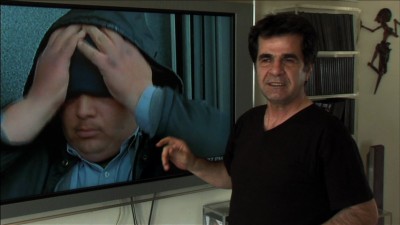
Panahi, after discussing some of the ins, outs, and recent developments of his case with Mirtahmasb (an effectively subtle way to fill in the viewer on the facts without breaking the conversational tone of the film), decides to make an experiment with his colleague, figuring out ways to "tell" his latest, censored and forbidden screenplay without actually shooting it for real, with actors on locations. The attempts that follow are enthused, illuminating, sometimes humorously awkward: In front of Mirtahmasb's high-end consumer-quality digital video camera, Panahi verbally relates the film's story; uses his camera phone to show tentative location-scouting video for the never-to-be-made film he's trying to tell us about, and his big-screen TV to run DVDs of his prior, completed films as a way to illustrate and discuss his ongoing thematics, aesthetics, and working methods; and finally uses masking tape and household items at hand to "block" a scene on his living-room floor, playing the part of the protagonist (a young girl who, in an eerie parallel to his own restrictions, has been legally consigned to life as a shut-in) and describing in a flight of intently focused imagination exactly how the shot would go, what it would look like, its duration, its meaning, etc. This experiment, which constitutes the film's middle third, is a huge risk for Panahi, not just on the legal level, and we feel that: A well-established, well-regarded, internationally-distributed and -acclaimed filmmaker reduced to hiding his now-forbidden work from the world and enacting a make-pretend version of his new script in his apartment could so easily be a vision of humiliation, a bitter protest in which dignity has to be sacrificed to make a point: "Look what they've reduced me to, how wrong and insulting that is." But it's the relentless attempts of ignorant, repressive forces trying to ground him down, not Panahi, that come off as impotent here. What Panahi is doing is an act of protest (or at least of defiance), to be sure, but one so joyful and redolent with meaning about the state of mind, the way of life, that comes naturally when one is an artist by vocation that you smile or laugh, not ruefully or in derision, but in complicit, carried-away excitement and engagement as Panahi stubbornly insists on practicing his vocation despite his sentence. He visibly needs to do this, needs to tell stories and share human experiences through this medium, and that need, as instinctive as hunger or thirst, must be slaked, to hell with any limitations of resources, petty legal restrictions on activity, or punitive government disapproval.
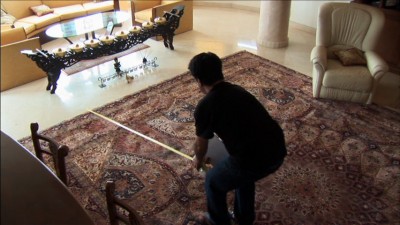
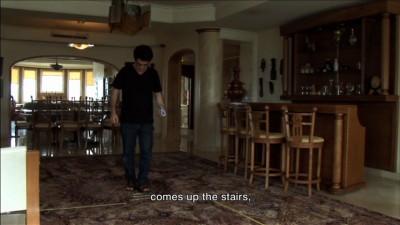
After thereby so compellingly illustrating that Panahi's quotidian life and his creative vocation are inseparable and continue to be so regardless of his predicament, This Is Not a Film's final third goes even further, into another dimension of simultaneous protest and allegory relating to the filmmaker's need to create: As Mirtahmasb departs, leaving the camera on and in position to continue documenting Panahi without the man's banned hands actually touching the camera (demonstrating once again that Panahi doesn't actually need to forcefully underline the ridiculousness of the terms imposed upon him through his banning), a young man, the building's substitute trash collector, edges by the two filmmakers to Panahi's kitchen and is intrigued by the camera watching him from the table. Panahi's interest in the life of his fellow citizens in particular, and in human experience/stories in general, kicks in when he discovers that the man is a fan and a struggling student of the arts himself (no mean feat in Iran's high-unemployment economy, which, like ours, hits students and the young especially hard). The filmmaker grabs his blurry/fuzzy camera phone for an impromptu interview (or is it? We're not quite sure at this point of what's spontaneous, what's been pre-planned/staged for This Is Not a Film) with the young man, and when the poor visual quality of the phone is questioned by his subject, Panahi's impulse carries him even further back into his nature and into punishable "offense" to pick up and handle Mirtahmasb's camera with his own hands (it's his hands operating the camera that would be the criminal act, and it's a gesture we don't see him make until this point; overhead phone conversations in the film suggest that others in the Panahi household have framed/focused and left the camera on before leaving). He follow the young man on the rest of his rounds, engaging him in a genuinely inquisitive, empathetic, and revealing conversation while he documents him at his work -- i.e., an unexpectedly, unemphatically triumphant conclusion comprised of Panahi's full-fledged re-engagement in the kind of Neorealist-influenced, subtle, patient, humanistic filmmaking he has done so well for so long and from which he is now legally prohibited. This blissful, unexpected immersion for Panahi (and us) in his most creatively life-giving waters is cut short, however, and what feels like a happy ending is complicated, when the elevator door opens on the lowest floor and the garbage collector emerges through gates outside which, we and Panahi seem to soberly realize at the same moment, Panahi would surely be recognized and arrested for his "crime" of holding the camera in his hands.
Throughout the film, we've heard fleeting mentions that it's the Persian holiday Nowruz (first day of spring, New Year's Day on the Persian calendar), and that the government, questioning the pre-Islamic roots of the celebration, will be cracking down on celebrants and their traditional fireworks. That conflict and tension, we realize, is at the root of the blazing mix of celebration and unrest glimpsed in the night outside those gates as we see them through Panahi's fully ready, capable, but reigned-in camera, and so This Is Not a Film has something of a tragic ending after all, an image of an uncrossable barrier coming on the heels of Panahi's nimble, eager storytelling-against-all-odds and his brief indulgence in freedom with the trash collector. This concluding note feels just right, though; in the end, the film does full justice to Panahi's restriction at the same time as it remains perfectly in keeping with his aesthetic vision, closing on a single, simple, highly loaded image, with the most possible being said through the least force or manipulation: There is much more life, many more important stories, to be engaged with out there, and for now, the eminently worthy Panahi will be officially and systematically denied the opportunity to do so in the way that's proved so essential and fruitful for him and for cinema audiences worldwide.
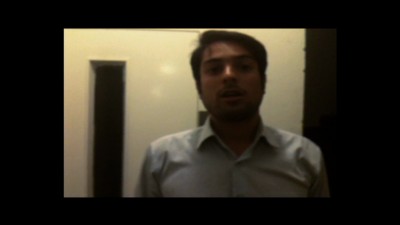
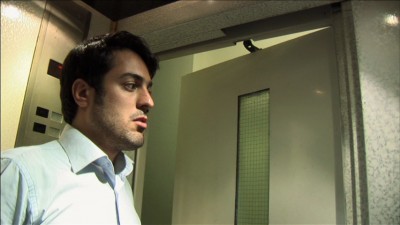
This Is Not a Film is an oddity, to be sure, and it inevitably carries with it its real-event historical actuality: Its star/director cannot legally be credited as the filmmaker, and so he pre-emptively shares a vague "an effort by" credit with his cameraman, Mirahsamb; the remaining credits are mostly redacting blanks because those involved in the film's making risk prosecution; the widely-reported way it was hidden in a cake to be smuggled to its audience outside of Iran has the air of a whimsical adventure story; and the title itself is a winking, ironical denial of accusations that have no legitimate grounds to begin with. But novelty has nothing to do with its intention or the way it works as a film. Panahi has somehow -- right in the midst of an ongoing persecution of the most serious consequence for himself, his raison d'être, and his family -- managed to take the long view, the broader perspective, the opportunity for contemplation and clarity about what his purpose is and what being an artist means when the chips are down. Like his other films, it's a fable that uses everyday life (his own, in this case) as its raw material and observes it in a way that subtly renders its significance much broader and deeper, revealing the specific events onscreen as relevant and meaningful far beyond their immediate moment. Panahi's case, whatever its outcome (and, following Panahi's unbelievably inspiring brand of undefeated stoicism, one hopes for the best while preparing for the worst), will lose its headline-grabbing status as time marches on, but the power of This Is Not a Film will outlast Panahi's tribulations. It works, certainly, to raise one's awareness of what is happening in the here and now, and it hardly trivializes or sells short the reality of Panahi's situation or the injustice of rightful freedom of expression so arbitrarily curtailed. But, effective as it is as a necessary, unavoidable act of protest, it also has the unusual foresight to go after and stick with the larger, more timeless subject overarching Panahi's case -- the impelled, inexorable human need to create, envision, express, communicate through art -- to the extent that its sense of immediacy, unlike that of any headlines created as Panahi's trial progresses, will never recede into the blur of a historical timeline.
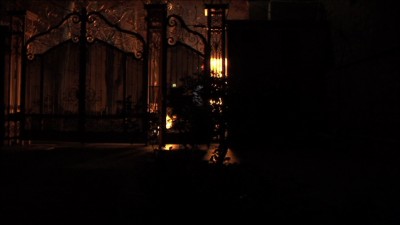
Video/Sound:
The DVD-R supplied by Tartan Palisades for review cannot be taken as a final indication, but what I saw there is a very good 1.78:1 anamorphic-widescreen transfer of the film that's entirely up to conveying the higher-def digital-video visual quality of most of the film and the blurry/rough hand-held-phone video imagery of some sections, with only a bit of aliasing and a minimum of edge enhancement/haloing, with no other compression artifacts at any point to distract from our time spent in the Panahi flat. This is, intentionally, far from a pristine-looking film to begin with, and if the check-disc format is this capable of getting its picture quality right, I imagine the finished product will easily pass muster.
As for the sound, the Dolby 2.0 stereo soundtrack (in Farsi with English subtitles, non-optional on the check disc) also sounded entirely up to snuff on the check-disc, perhaps even better than the limited-technology/no-crew approach of the film would lead you to expect, with every bit of spoken dialogue and ambient sound both solid and free of distortion.
Extras:--The best extra is eight minutes of excerpts from an interview with Panahi by Iranian expat film professor Jamsheed Akrami, in which the filmmaker offers further insights into his own experience and currently embattled situation as a frequently-censored, now-banned Iranian filmmaker, and his thoughts and positions on the general oppression of filmmakers in Iran, the demands and sacrifices they undergo as they work (and they do continue to work, against the odds) under the thumb of state censors who, according to Panahi, generally don't understand cinema and whose ignorance is slyly mocked by many Iranian filmmakers whenever possible.
--A feature commentary by Jamsheed Akrami, which unfortunately is an object lesson in how not to do a commentary. Akrami, clearly an expert, has a handful of insightful things to say, but he wastes at least three-quarters of his (and our) time getting to the actual commentary by merely describing, as a play-by-play and nothing else, what's going on at this moment onscreen ("so now...he's making some tea"), the redundancy of which -- unless deployed as a distancing device by Robert Bresson, for example -- is deadly. A textbook illustration that commentary is not just description, but description (when used) parlayed into an observation (or, otherwise put -- a comment!).
--The film's theatrical trailer (which seems a bit misleading and trivializing with its added sound effects and hyped-up editing), along with several previews for other Tartan Palisades DVD releases.
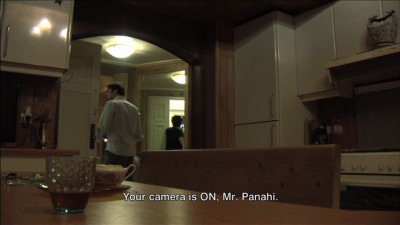
Is it a documentary, or something that just effortlessly attains the spontaneous appearance of documentary as part of its aesthetic strategy? Is it a day in the life, or an allegory pointing to a more general theme? Is it an act of protest or a work of art? Jafar Panahi's This Is Not a Film is, successfully, all of these things at once, a movie very much of its moment that will also retain its impact decades from now -- a handmade, intimate act of filmmaking spun into something momentous in the way only a very inspired and very resourceful artist could manage. As politically important and immediately consequential as Panahi's case is (it seems very likely that he will actually serve prison time for no more egregious an "offense" than making films that don't quite meet the Iranian government's theocratic standards), what makes This Is Not a Film so unique, elating, and devastating is neither the martyrdom of Panahi at the hands of his bureaucratic oppressors (he seems bemused and worried, but not at all defeated, either as an individual or as an artist), nor any (probably misbegotten) hopes that his right to free expression will be vindicated as his case plays out in the Iranian courts. Rather, it's the film's (that is to say, Panahi's) brave, bold, unbelievably imaginative repurposing of a horrendously unjust situation, its use of Panahi's own suffering and highly uncertain situation to conjure up a lens through which we glimpse a broadly, perhaps universally recognizable idea about what it means to be an artist -- the true, bone-deep necessity of creating that drives someone like Panahi, all limitations or barriers be damned -- that makes it so unshakably resonant, and such essential viewing for all. Highly Recommended.
|
| Popular Reviews |
| Sponsored Links |
|
|
| Sponsored Links |
|
|
| Release List | Reviews | Shop | Newsletter | Forum | DVD Giveaways | Blu-Ray | Advertise |
|
Copyright 2024 DVDTalk.com All Rights Reserved. Legal Info, Privacy Policy, Terms of Use,
Manage Preferences,
Your Privacy Choices | |||||||









